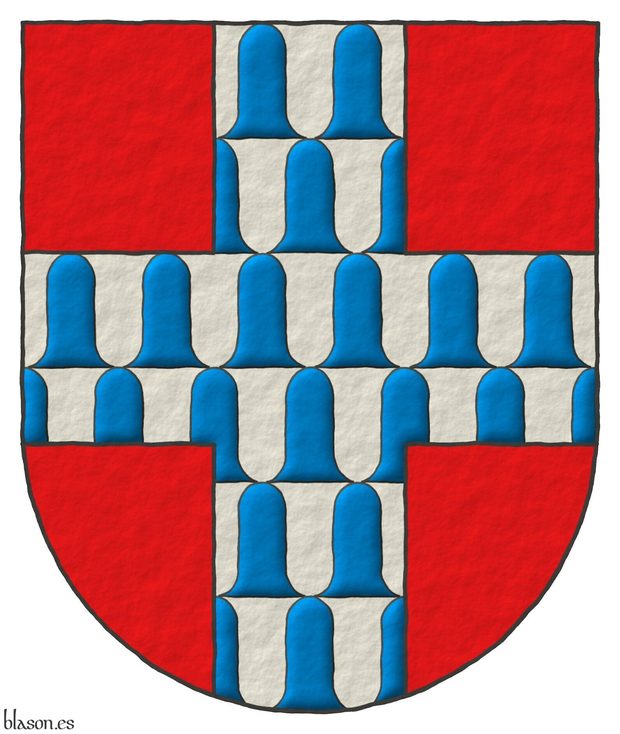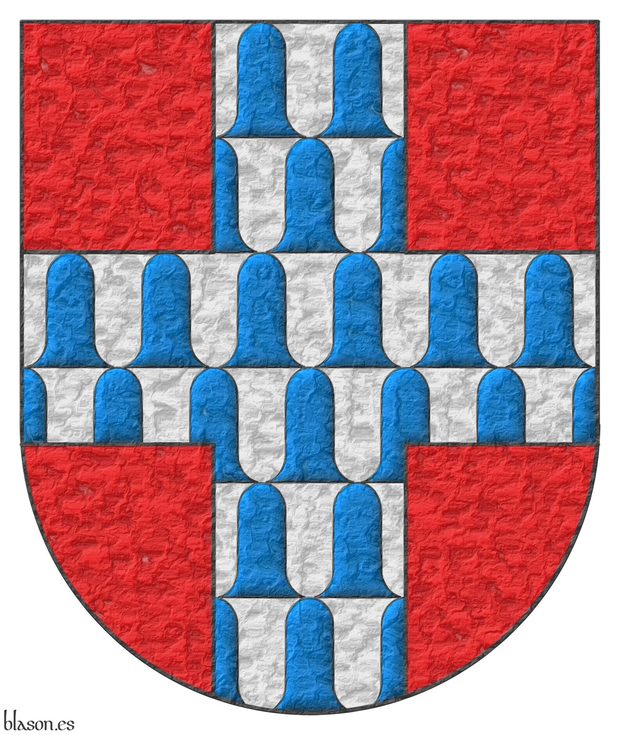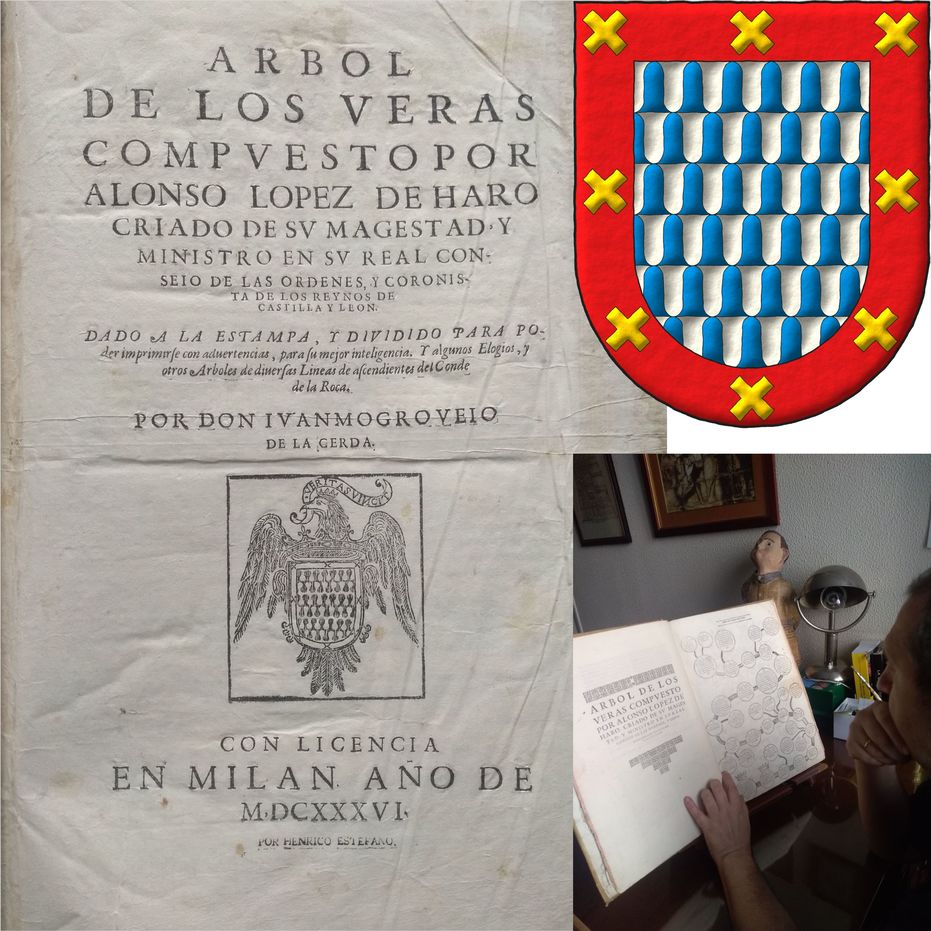Vair ancient


Albero, lineage of Aragon

Blazon of the Albero lineage of Aragon.
Vair ancient.
Escudo de veros antiguos.
Illuminated and with a glass finish.
It can be consulted in [Cadenas y Vicent, V. de; 1987; page 62].
[Friar, S.; 1987; pages 157-158] says of the veros: «originates from the fur of a species of squirrel... which was popular in the Middle Ages as a lining for the garments of those not entitled to wear ermine. The animal was blue-grey on the back and white underneath. By sewing a number of these pelts together, with white and blue-grey alternating,... one which easily translated into the stylized armorial form of Vair and its variants».
Blazon keywords: Vair ancient.
Style keywords: Freehand, Outlined in sable, Illuminated and Semi-circular.
Classification: Interpreted, Lineage and Coat of arms.


Argote de Molina, Gonzalo

Gules, a cross vair ancient.
Escudo de gules, una cruz de veros antiguos.
Coat of arms that I have interpreted as follows: the shield has a semicircular (round) base; the field is in flat tincture of Gules; the ancient vair, rounded or of the old form, which are always Argent and Azure, are illuminated and outlined in Sable; and the whole of the hereditary coat of arms has a raised-stroke drawing.
Este escudo puede encontrarse en el libro del propio [Argote de Molina, G.; 1588; páginas 14 y 168], en la página 14 en grande, con cimera y rodeado de otros escudos de menor tamaño y en la página 168 de menor tamaño, con yelmo y lambrequines. En ambos casos el trazado de los veros es antiguo, redondeados, y en estas interpretaciones así los he reflejado.
Blazon keywords: Without divisions, Gules, Argent, Azure, Cross and Vair ancient.
Style keywords: Freehand, Illuminated and Outlined in sable.
Classification: Interpreted, Personal, Coat of arms and Heraldry and heralds.
Bearer: Argote de Molina, Gonzalo.


Gonzalo Argote de Molina

Gules, a cross vair ancient.
Escudo de gules, una cruz de veros antiguos.
Coat of arms that I have interpreted as follows: the shield has a semicircular (round) base; the field is in flat tincture of Gules; the vair ancient, rounded in the old style, are outlined in Sable and illuminated; and the whole has a raised-stroke drawing.
The coat of arms of the commune of Bailleul is very similar to this coat of arms, with the difference that it is of regular vair instead of ancient, rounded vair, like that borne by Gonzalo Argote de Molina.
Blazon keywords: Without divisions, Gules, Argent, Azure, Cross and Vair ancient.
Style keywords: Semi-circular, Illuminated, Outlined in sable and Metal beaten.
Classification: Interpreted, Personal, Coat of arms and Heraldry and heralds.
Bearer: Argote de Molina, Gonzalo.


![Ver [Mogrovejo de la Cerda, J.; 1636] en referencias bibliográficas. Libro abierto, hojas de plata, filo de oro, guardas de gules, tapas de sable.](../css/Libro.Bibliografia.png)
Mogrovejo de la Cerda, J.; 1636
Juan Mogrovejo de la Cerda, «Árbol de los Veras compuesto por Alonso López de Haro, Criado de Su Majestad y Ministro de su Real Consejo de las Órdenes y Cronista de los Reinos de Castilla y León», bound in original parchment, Milan, 1636.
Contents
The book contains a total of 66 main genealogical trees, each with an average of 28 nodes/persons, totaling over 1700 nodes. Additionally, it includes 41 lines of descent with approximately 1150 individuals. The content is composed of:
- Title page with the coat of arms of the Veras.
- Errata and additions.
- Dedication.
- Warnings and introduction by Juan Mogrovejo de la Cerda, folios 1 to 4.
- Tree of the Veras, folios 6 to 66, with 61 genealogical trees.
- Eulogies of five Christian princes known for their virtue and valor, with trees of their descendants up to the Count of La Roca, folios 67 to 72.
- Linear trees of descent from Don Fernando Carlos Antonio de Vera, Doña María Antonia de Vera y Tovar, and Doña Catalina de Vera, folios 73 to 114, with 41 trees.
- Limitations of the work on folio 115.
- Indexes with handwritten corrections, folios 116 to 122.
- Additions to the edition, including a genealogical tree of Don Luis Francisco de la Cerda Sandobal y Rojas, Marqués de Alcalá.
- Additional handwritten documents attached but not bound.
In the previous image, The canting arms of Juan Antonio de Vera y Zúñiga, Count of La Roca, in this book about his genealogy, are canting because «vair~veros~Vera».
The motto in the beak of his sable eagle is «Veritas Vincit», although some authors claim that not all his trees honor this motto [Vera-Ortiz, J.A.; 2009].
The colored version of the coat of arms in this image was painted by me. Blazon: Vair ancient, a bordure gules charged with eight saltires couped Or.
Bibliographical reference of century XVII.
Classification: De bibliotheca, In black and white and Castilian language.
The author is Mogrovejo de la Cerda, Juan.
Here are the articles quoting this reference:
External link:
Internal resources: Physical book..


Vera, lineage of Aragon

Blazon of the Vera lineage of Aragon.
Vair ancient, a bordure gules charged with eight saltires couped Or.
Escudo de veros antiguos, una bordura de Gules cargada de ocho sotueres cortados de oro.
Illuminated and with a glass finish.
It can be consulted in [Mogrovejo de la Cerda, J.; 1636; cover].
[Friar, S.; 1987; pages 156-157] says of the vair: «originates from the fur of a species of squirrel... which was popular in the Middle Ages as a lining for the garments of those not entitled to wear ermine. The animal was blue-grey on the back and white underneath. By sewing a number of these pelts together, with white and blue-grey alternating,... one which easily translated into the stylized armorial form of Vair and its variants».
Blazon keywords: Vair ancient, One, Bordure, Gules, Charged, Eight, Saltire, Party per fess and Or.
Style keywords: Freehand, Outlined in sable, Illuminated and Semi-circular.
Classification: Interpreted, Lineage and Coat of arms.
-
Language
-
Categories of heraldry
-
Divisions of the field
- Without divisions
- Party per pale
- Party per fess
- Party per bend
- Party per bend sinister
- Tierce
- Tierce sinister
- Tierced per pale
- Tierced per fess
- Tierced per bend
- Tierced pallwise inverted
- Quarterly
- Quarterly per saltire
- Gyronny
- Party per fess, the chief per pale
- Party per pale, the sinister per fess
- Party per fess, the base per pale
- Party per pale, the dexter per fess
- Chapé
- Chaussé
- Embrassé
- Contre-embrassé
- Party per chevron
- Enté
- Enté en point
- Flanched
-
Metals
-
Colours
-
Furs
-
Other tinctures
-
Ordinaries and sub-ordinaries
-
Diminutives of the ordinaries
-
Geometric charges
-
Composite ordinaries
-
Inanimate charges from Nature
Atom, Crescent, Diamond, Emerald, Estoile, Increscent, Lightning flash, Moon, Mount, Mullet, Mullet of four points, Orbital, Plough of Ursa Major, Rainbow, Ray of the sun, River, Sea, Snowflake, Sun, Sun in splendour, Sun of May, Trimount, Water and Wave.
-
Vegetal charges from Nature
Acorn, Apple, Apple tree, Ash, Bluebonnet, Camellia, Chrysanthemum, Cinquefoil, Cornflower, Dogwood flower, Double rose, Elm, Fleur de lis, Flower, Gourd, Holm oak, Hop cone, Kapok tree, Laurel, Lily, Linden, Lotus flower, Madonna lily, Mexican cedar tree, Oak, Olive tree, Palm tree, Plantain plant, Pomegranate, Poplar leaf, Rose, Shamrock, Sunflower, Thistle, Tree, Tulip, Vine and Wheat.
-
Animal charges from Nature
Badger, Bald eagle, Barbel, Barn owl, Bear, Beaver, Beetle, Bighorn sheep, Blackbird, Boar, Brach hound, Bull, Doe, Dog, Dolphin, Dove, Eagle, Elephant, Falcon, Female figure, Fish, Flame, Fly, Fox, Frog, Goat, Goldfinch, Goose, Heron, Horse, Hummingbird, Jaguar, Lark, Leopard, Lion, Lion passant, Lion rampant guardant, Lioness, Lynx, Male figure, Martlet, Merino ram, Owl, Panther, Parrot, Peacock, Pelican, Pelican in her piety, Puffin, Quetzal, Raven, Roe deer, Rooster, Savage, Seagull, Serpent, She-wolf, Stag, Starling, Talbot, Tyger, Vulture, Warren hound and Wolf.
-
Parts of natural charges
Arm, Beak, Branch, Caboshed, Chest, Claw, Covert, Dorsal fin, Eagle claw, Ermine spot, Escallop, Feather, Foot (palmiped), Foreleg, Forepaw, Hand, Head, Heart, Hoof, Leaf, Neck, Ostrich feather, Palm frond, Paw, Roe deers' attires, Shoulder, Sprig, Stags' attires, Stem, Swallow-tail, Tail, Tail addorsed, Tail fin, Talon, Tooth, Trunk, Trunk (elephant), Two hands clasped, Two wings in vol, Udder, Wheat spike, Wing and Wrist.
-
Artificial charges
Ace of spades, Anchor, Anvil, Arch, Arm vambraced, Armillary sphere, Arrow, Axe, Bell, Bell tower, Beret, Bonfire, Book, Bookmark, Bow, Branding iron, Bridge, Broken, Buckle, Cannon, Cannon dismounted, Cannon port, Canopy roof, Carbuncle, Castle, Celtic Trinity knot, Chain, Chess rooks, Church, Clarion, Clay pot, Closed book, Club, Column, Comb, Compass rose, Conductor's baton, Cord, Covered cup, Crozier, Crucible, Cuffed, Cup, Cyclamor, Dagger, Double vajra, Drum, Ecclesiastical cap, Fanon, Federschwert, Fleam, Four crescents joined millsailwise, Galician granary, Garb, Gauntlet, Geometric solid, Grenade, Halberd, Hammer, Harp, Host, Hourglass, Key, Key ward, Knight, Knot, Lantern, Letter, Line, Loincloth, Menorah, Millrind, Millstone, Millwheel, Monstrance, Mortar, Mullet of six points pierced, Nail, Non-classic artifact, Norman ship, Number, Oar, Oil lamp, Open book, Page, Pair of scales, Parchment, Pestle, Piano, Pilgrim's staff, Plough share, Polish winged hussar, Port, Portcullis, Potent, Quill, Ribbon, Rosette of acanthus leaves, Sabre, Sackbut, Sail, Scroll, Scythe, Sheaf of tobacco, Ship, Skirt, Spear, Spear's head, Stairway, Star of David, Step, Sword, Symbol, Tetrahedron, Torch, Tower, Trident, Trumpet, Turret, Two-handed sword, Wagon-wheel, Water-bouget, Wheel, Winnowing fan and With a turret.
-
Immaterial charges
Angel, Archangel, Basilisk, Dragon, Dragon's head, Garuda, Golden fleece, Griffin, Heart enflamed, Justice, Mermaid, Our Lady of Mercy, Ouroboros, Paschal lamb, Pegasus, Phoenix, Sacred Heart of Jesus, Saint George, Sea-griffin, Trinity, Triton, Unicorn, Winged hand and Wyvern.
-
External elements
-
Heraldic creations
-
References
-
Formats
-
Keywords on this page
Argote de Molina, Gonzalo, Azure, Bibliography, Bordure, Charged, Heraldry and heralds, Party per fess, Cross, De bibliotheca, Outlined in sable, In black and white, Coat of arms, Genealogy, Personal, Gules, Illuminated, Interpreted, Castilian language, Lineage, Semi-circular, Metal beaten, Eight, Or, Argent, Without divisions, Century XVII, Saltire, Freehand, One and Vair ancient.

